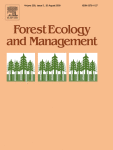Ver ítem
- xmlui.general.dspace_homeCentros Regionales y EEAsCentro Regional Patagonia NorteEEA BarilocheArtículos científicosxmlui.ArtifactBrowser.ItemViewer.trail
- Inicio
- Centros Regionales y EEAs
- Centro Regional Patagonia Norte
- EEA Bariloche
- Artículos científicos
- Ver ítem
Variation of wood density and hydraulic properties of Douglas-fir (Pseudotsuga menziesii (Mirb.) Franco) clones related to a heat and drought wave in France
Resumen
Drought response of three Douglas-fir clones (slow, intermediate and fast growing) inhabiting two different climatic regimes in France was examined.We used the hydraulic conductivity and the percent loss of conductivity due to embolism from stems and branches as well as wood microdensity measurements to determine the role of genetics in the control of embolism in this species. Conductivity
and tree-ring’smicrodensity variables (ring width: RW, mean ring
[ver mas...]
Drought response of three Douglas-fir clones (slow, intermediate and fast growing) inhabiting two different climatic regimes in France was examined.We used the hydraulic conductivity and the percent loss of conductivity due to embolism from stems and branches as well as wood microdensity measurements to determine the role of genetics in the control of embolism in this species. Conductivity
and tree-ring’smicrodensity variables (ring width: RW, mean ring density: MRD, minimum ring density: MID andmaximum ring density:MAD)were compared in growth rings in all three clones during a typical year (2002) vs. an extremely dry year (2003). A new method was developed in order to assess axial hydraulic specific conductivity (Ks) within tree rings. The results show that branches are more resistant to embolism than stems, and that there are significant differences in embolism resistance among the clones
between the two sites. Ks varied between years, sites and clones but the site exerted the most significant effect. Lartimache (more humid site during 2003) trees showed substantially higher Ks than those inhabiting Chassenoix (strongly affected by the 2003 heat and drought wave site). Wood analysis showed a significant year effect for all ring variables and a significant clone effect for all ring variables except for MAD, while the site effect was significant for MRD and MAD. The existence of a genetic control for the study traits indicates that Douglas-fir populations introduced in France may have a selection potential to face extreme climate events like the 2003 heat and drought wave.
[Cerrar]

Autor
Dalla Salda, Guillermina;
Martinez Meier, Alejandro;
Cochard, Hervé;
Rozenberg, Philippe;
Fuente
Forest Ecology and Management 257 (1) : 182-189 (Enero 2009)
Fecha
2009-01
Editorial
Elsevier
ISSN
0378-1127
Formato
pdf
Tipo de documento
artículo
Palabras Claves
Derechos de acceso
Restringido
 Excepto donde se diga explicitamente, este item se publica bajo la siguiente descripción: Creative Commons Attribution-NonCommercial-ShareAlike 2.5 Unported (CC BY-NC-SA 2.5)
Excepto donde se diga explicitamente, este item se publica bajo la siguiente descripción: Creative Commons Attribution-NonCommercial-ShareAlike 2.5 Unported (CC BY-NC-SA 2.5)

